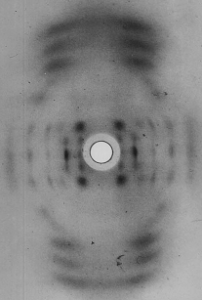![]() One of the most wonderful things about science, to my mind, is the way its fundamental principles are simultaneously both universal and personal. Quantum physics helps to explain the nature of grandiose concepts such as time and space, but it also applies to the insignificant particles that make up my own cells. Equally, within these very cells, at any moment, biological processes newly reported in the literature are taking place, as are those that have yet to be discovered.
One of the most wonderful things about science, to my mind, is the way its fundamental principles are simultaneously both universal and personal. Quantum physics helps to explain the nature of grandiose concepts such as time and space, but it also applies to the insignificant particles that make up my own cells. Equally, within these very cells, at any moment, biological processes newly reported in the literature are taking place, as are those that have yet to be discovered.

Life's secret
For this reason, when I look at one of the beautiful X-ray diffraction photos taken by Rosalind Franklin and her PhD student Ray Gosling in the early 1950s, from painstaking work performed on calf thymus samples in gloomy basements by the banks of the River Thames, I know that my own DNA could produce just such an image: the stark, spotty diamond patterns that tell the secret of the double helix – and, with it, the secret of life itself.
Today is DNA60, the 60th anniversary of the three seminal Nature papers that first described DNA's double helical nature. Watson and Crick's paper – the best known of the three – presented the double helix model of DNA’s structure, astounding in its simplicity and elegance. Most of all, the paper was shocking because the structure itself revealed the mode of genetic replication, and in doing so proved beyond doubt that DNA was the stuff of genes, the chemical of genetic inheritance. Nature is rarely so kind in its revelations, and seldom so memorable.
Rosalind Franklin, Ray Gosling and the King's version of the double helix story
Also remarkable in Watson and Crick's paper was the total absence of experimental data; instead, they had used X-ray diffraction data generated by Franklin and Gosling as the basis for their model. These data were published in an accompanying paper, and so acquired parity of sorts in the literature, but Watson and Crick had very much won the race to the double helix.
It's often said that, well – to the victor the spoils! And so it was with DNA: Watson wrote a book that became the best known account of the double helix's discovery. Many years later, however, a different perspective, by Rosalind Franklin's biographer, attracted some attention and, as a result, more emphasis is now placed on the role of Franklin and her colleagues at King's College London.

On this, the 60th anniversary, Genome Biology publishes yet another account of the story, that of Ray Gosling, Franklin's PhD student. Gosling describes how he was the first person to crystallize DNA, before Franklin was even involved in the project. What had been fuzzy patterns were suddenly dazzling diamonds, and it's an image that leaves Gosling in awe to this day.
Over at Biome, you can listen to an audio excerpt of our interview with Gosling, in which he describes – with some amusement – a trip made by the King's DNA team to Cambridge, where they viewed Watson and Crick's lesser known first model. As Franklin was very quick to point out, this beginner's attempt contained a number of major errors.
DNA: past, present and future
As a further celebration of DNA60, we canvassed our Editorial Board members for their most memorable moments in the field of genome biology since the double helix. The clear emergence of introns as a favorite discovery will no doubt be pleasing to those nostalgic for the pre-omics days of classical biology, and you can read a free excerpt of this section of the article at Biome.
Outside of introns, selections included the human and mouse genome projects and sequencing technologies. Recent improvements in the sensitivity of the latter of these has of course brought about the era of the data deluge and a high demand for bioinformaticians. So how better to round off our honoring of DNA Day than with a 5-step DNA60IFX Bioinformatics Challenge?
Update: The winners of our DNA60IFX Bioinformatics Challenge were announced at 8 pm Eagle Time, DNA Day. Although the challenge has now concluded, we've left the puzzles open for anyone who would like to try them out for fun. For more info, please see the Challenge homepage.
See also: We reviewed the Wellcome Trust's special DNA60 conference, 'Genomic Disorders 2013: From 60 years of DNA to human genomes in the clinic', here.
Latest posts by Naomi Attar (see all)
- tRFs and the Argonautes: gene silencing from antiquity - 2nd October 2014
- Keeping up with the Jobses: the role of technology in reproducible research - 26th September 2014
- How to disarm a superbug – a story told by forensic genomics - 23rd June 2014
2 Comments